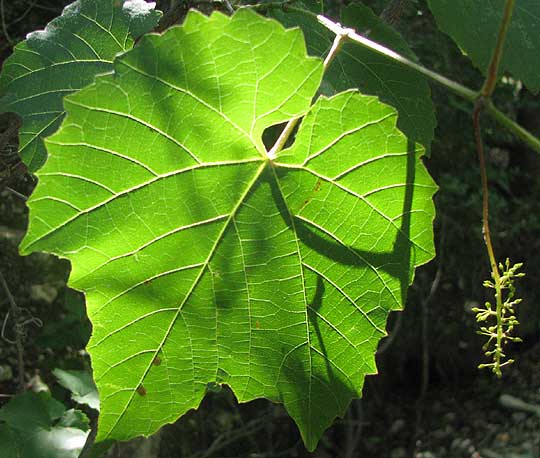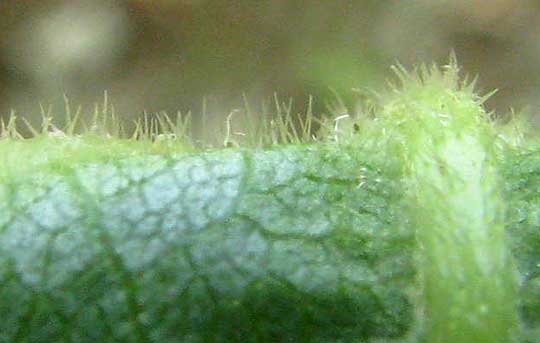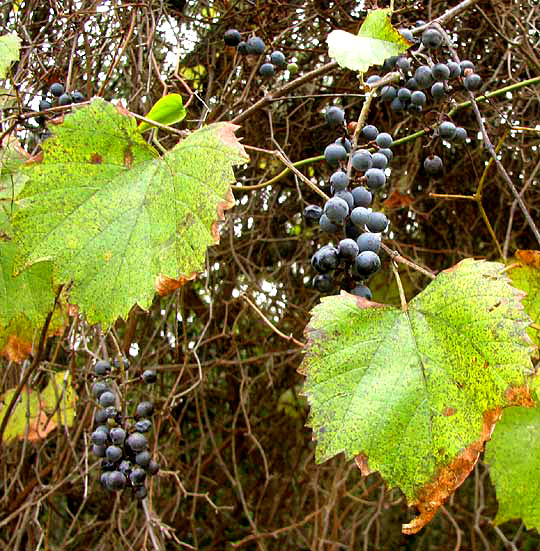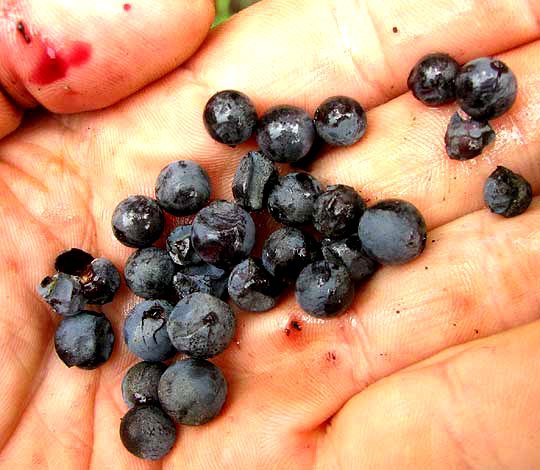Excerpts from Jim Conrad's
Naturalist Newsletter
from the June 2, 2013 Newsletter issued from the Frio Canyon Nature Education Center in northern Uvalde County, southwestern Texas, on the southern border of the Edwards Plateau; elevation ~1750m (~5750 ft); N29.62°, W99.86°; USA
SWEET MOUNTAIN GRAPE
On a vine twining up through the branches of a Sycamore in the shade of the Dry Frio River's cliff behind the cabin a very pretty sight attracted my attention, shown below:

I've always thought that hardly anything could be prettier than the way sunlight shines through a grapevine leaf, so I just stood awhile admiring this glowing creation, even taking a while before I began wondering which species it was. For, it was surprising to find any grape species at all growing here because of the arid climate. Maybe this was a special species.
The flowers were too undeveloped to provide much information. But that was OK since in grapevine identification the leaves are so important -- which is unusual. Normally features of flower and fruit are more important by far. One way that grapevine leaves differ from species to species is by the nature of the hairs on the leaves' undersurface -- if there are any -- and by how much hair there is. Therefore, I doubled up a leaf so I could see how hairy its underside was, and saw what's shown below:

This species' leaf undersides are fairly hairy, and the hairs are straight and unbranched. That, and the fact that the leaves were uncommonly small, only shallowly lobed, and, especially, that it grows here in this arid land, eventually led me to the name, which is Sweet Mountain Grape, VITIS MONTICOLA. It's endemic to only a handful of counties in southwestern and central Texas.
So, this is a good find, and I read that the species is an important one to the grape-growing industry because the Sweet Mountain Grape is especially drought tolerant. Thus it's much used to impart that quality when viticulturists create hybrid stock, and graft.
And you know what joy wild grapes are to wildlife and humans.
What a fine little being grows there among the Sycamores in the shade of the cliff behind the cabin.
from the November 3, 2013 Newsletter issued from the Frio Canyon Nature Education Center in the valley of the Dry Frio River in northern Uvalde County, southwestern Texas, on the southern border of the Edwards Plateau; elevation ~1750m (~5750 ft); N29.62°, W99.86°; USA
SWEET, JUICY WILD GRAPES
In steamy June flowers were just beginning to form on our Sweet Mountain Grapevines, and it was hard to guess whether the grapes they'd produce would be worth eating or not. Now the grapes are ripening, as shown below:

Both leaves and fruits of this species are small, so to give you a better idea of the grapes' size, you can see some in my hand below:

I still don't know why the word "mountain" is in their name, but I can tell you that the "sweet" is there because these little grapes are deliciously sweet, with their own special, sweet-nutty flavor. Just rake a cluster through your fingers, remove bugs from the resulting crop in your hand, and eat. Of course the grapes have their share of seeds, but the seeds are so tiny and soft that I just chew them up and don't bother with spitting.
Earlier I mentioned that though our Sweet Mountain Grapes occur naturally only in a handful of counties in Texas, the species is an important one to the worldwide grape-growing industry because it's especially drought tolerant. Thus it's much used by viticulturists to impart drought resistance to hybrid and grafted stock.